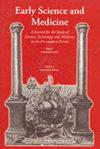Can There Be Two Perfectly Identical Complexions? Peter of Abano and Jacopo of Forlì on Avicenna’s Interdict
IF 0.5
2区 哲学
Q3 HISTORY & PHILOSOPHY OF SCIENCE
引用次数: 0
Abstract
Avicenna, in Book有两种完全相同的肤色吗?阿巴诺的彼得和Forlì的雅格布谈阿维森纳的禁令
阿维森纳在《正典》第一卷中,在他关于肤色的一般学说的背景下,提出了关于特定或个人肤色的八种平等模式(modi aequalitatis)。在那里,他非常清楚地指出,人类物种中的每个个体都拥有专属于该个体的肤色,并且不可能将其与另一个个体联系起来。在这篇文章中,在对面相传统中关于肤色的个性和不可重复性的讨论的一些特征(特别是关于双胞胎)进行了简要的调查之后,我将考虑对阿维森纳禁令的两种不同看法:第一种,与波斯哲学家和医生相呼应,是由阿巴诺的彼得在他的调解者中提出的;另一个是Forlì的雅格布,在他的《超级首要和次要首要的问题》一书中,他似乎小心翼翼地与阿维森纳的权威保持距离。这两种中世纪反应之间的对比使我们能够把握肤色作为解释同一物种个体之间差异的理论工具的重要性——这些差异不仅仅是随机的或偶然的,也不是严格形式上的。
本文章由计算机程序翻译,如有差异,请以英文原文为准。
求助全文
约1分钟内获得全文
求助全文
来源期刊

Early Science and Medicine
HISTORY & PHILOSOPHY OF SCIENCE-
CiteScore
0.50
自引率
0.00%
发文量
22
审稿时长
>12 weeks
期刊介绍:
Early Science and Medicine (ESM) is a peer-reviewed international journal dedicated to the history of science, medicine and technology from the earliest times through to the end of the eighteenth century. The need to treat in a single journal all aspects of scientific activity and thought to the eighteenth century is due to two factors: to the continued importance of ancient sources throughout the Middle Ages and the early modern period, and to the comparably low degree of specialization and the high degree of disciplinary interdependence characterizing the period before the professionalization of science.
 求助内容:
求助内容: 应助结果提醒方式:
应助结果提醒方式:


